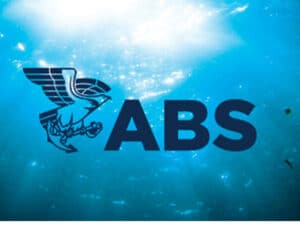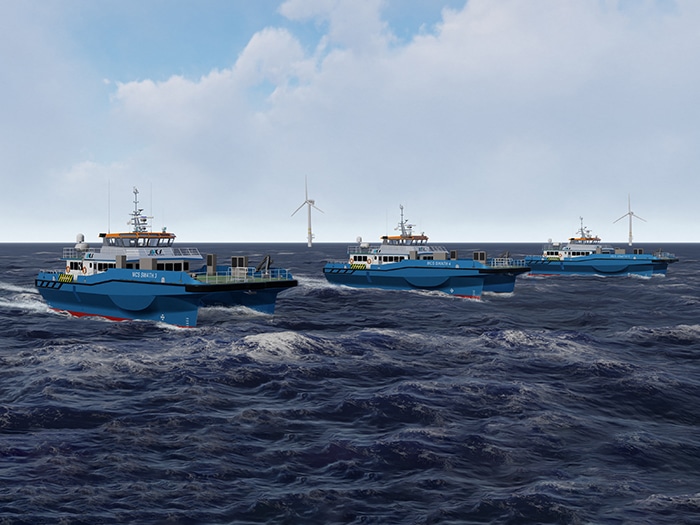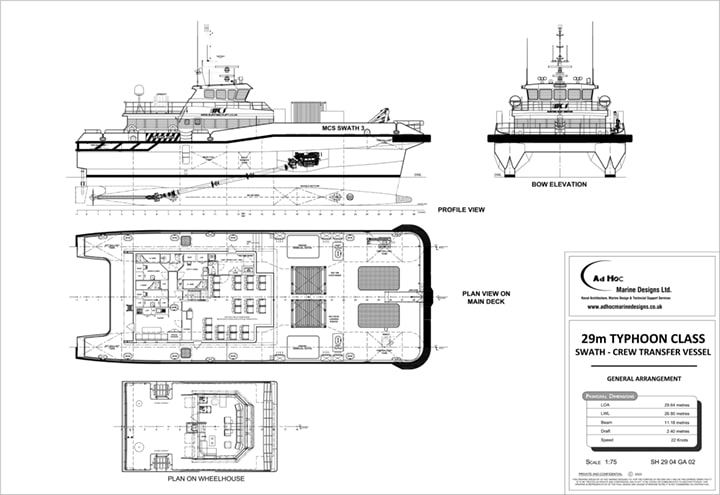
Maritime Craft Services orders CTV trio with new advanced SWATH design
Written by Nick Blenkey
Image: AHMD
Scotland’s Maritime Craft Services (Clyde) Ltd has ordered three new crew transfer vessels (CTVs) at the Työvene shipyard in Finland. Built to new design by Sandown, U.K., based Ad Hoc Marine Design (AHMD) they feature an advanced SWATH (small waterplane area, twin hull) design that concentrates a large proportion of the vessel’s floatation volume into bulb-like hull sections deep beneath the waterline. These support the weight of the vessel through narrow, hydrodynamically efficient hull struts and, in the case of the AHMD design, have additional motion stabilization with zero speed heave mode controllable fins.
The vessel’s engines, fuel and other heavy equipment are contained within the upper haunch region for easy access and maintenance from the main deck, allowing the struts to only require minimal wiring and plumbing to pass through them and enabling them to be made very narrow and hydrodynamically efficient. The main advantages claimed for a SWATH hull form over a more traditional monohull or catamaran are twofold: The efficiencies derived from a low waterplane area and decreased vertical accelerations in rough sea conditions which allow a wider window of operation with more comfort for passengers and crew.
Particularly at slow speeds, a correctly designed SWATH hull offers significant CO2 reductions over a comparable catamaran or monohull.
The reduced waterplane area gives a SWATH hull improved seakeeping. A vessel’s volume distribution and waterplane area are what causes it to heave and pitch as it passes through waves. Reduce the waterplane area and the designer reduces the heaving and pitching forces that waves can exert on the vessel. Adding motion control fins to the SWATH hulls as in this design reduces these vertical accelerations even further, making for a seakindly ride, at any speed and sea state.

While SWATH designs have been around for many decades, the number of naval architects and shipyards worldwide that can routinely produce SWATHs delivering all the promised advantages is limited.
“For more niche designs such as SWATH hulls there is nowhere near as much prior art as there is for more conventional hull forms,” says AHMD naval architect John Kecsmar. ”Ad Hoc Marine Designs has been involved in highly successful and proven SWATH designs for more than 30 years, and these range from 13 meters in size up to current SOV designs of 71 meters. Our back catalog of successful SWATH designs spans from our first SWATH MV Patria in the late 1980s, still the world’s fastest SWATH, as well as the naval architecture design of the Lockheed Martin SLICE SWATH, to our latest range of world-class Typhoon Class of CTV SWATHs that are extending the North Sea operational window by more than 3 months per year.”
An extension of the existing two Typhoon Class SWATH CTVs currently operated by Maritime Craft Services, these new fully IMO Tier III compliant designs offer an IMO specification ballast water management system, and are hybrid ready.
The advanced SWATH vessels will carry 30 tonnes of deadweight along with 24 technicians in comfortable business class seating with low risk of seasickness thanks to the extremely low motions of a SWATH hull form.
This new advanced SWATH design is a larger version of the successful Typhoon Class of SWATHs currently operated by MCS, pushing the safe operational envelope from an Hs (significant wave height capability) of 2.5 meters to Hs=3.0m.
The major advantage of the SWATH design is its superior response to high seas allowing operation up to an extra 100 days a year over a conventional catamaran,” says Menno Kuyt, Commercial Director at Maritime Craft Services.
In addition, says AHMD, this advanced hull form exhibits extremely low resistance at low/loitering speeds. This current SWATH hull form requires less than 50% of the power required by an equivalent size and displacement conventional vessel when operating at slow speed, thereby reducing fuel consumption and CO2 emissions.




